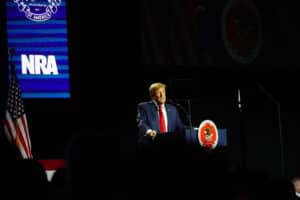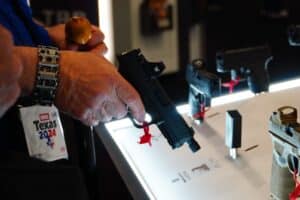Kamala Harris opted for a gun-rights supporter turned gun-control advocate as her Vice Presidential pick. His journey on guns mirrors that of Democrats as a whole.
Harris recently named Minnesota Governor Tim Walz (D.) as her running mate, solidifying the Democratic ticket. It’s a pick that, much like Donald Trump’s selection of Ohio Senator JD Vance, represents a doubling down on the gun policies at the top of the ticket.
The conventional wisdom for Vice Presidential picks in previous cycles has traditionally been to bring a sense of balance to the ticket by reassuring voters with a candidate from the opposite wing of the party as its Presidential nominee.
Superficially, Walz fills the role. He brings a folksy, plain-speaking midwestern persona and a history of representing rural constituencies that contrasts with Harris’ brand of urban coastal progressivism. Yet, on policy substance, the two are cut from similar cloth.
In particular, the two champion essentially the same policies on guns. Ever since Harris’ campaign recently walked back her attempts to push for a mandatory buyback of AR-15s and similar firearms, she has repeatedly hammered home a policy platform centered around universal background checks, red flag laws, and an assault weapons ban while on the campaign trail. Since being elected Governor in 2018, Walz has supported the same basic policies. He signed bills enacting expanded background checks and a red flag system in Minnesota just last year. He has continued to push for an assault weapon ban in the state as well.
Walz mirroring of Harris’ gun-control platform appears to have been a feature, rather than a bug, in what made him a compelling VP candidate. After all, he and nearly every single other potential nominee rumored to be on Harris’ short list for Vice President had essentially the same track record of supporting the same basic gun-control policies. It is a remarkable degree of ideological unanimity, especially because the Harris campaign was intentional about fielding candidates who would generally be perceived as more moderate by the general electorate. In recent political memory, support for a ban on the most common rifle in the country wasn’t typically associated with moderate candidates.
Explicitly pro-gun Democrats, while never a majority coalition, nevertheless used to represent a substantial chunk of the American political landscape. Now, they’ve all but disappeared entirely. One need only look at the trajectory of National Rifle Association (NRA) endorsements by party over the last few election cycles to see how this shift has played out.
As recently as 2008, there were 67 Democrats elected to Congress with an A-rating from the NRA, according to a New York Times analysis. Another 13 were given a B-rating by the group that same year. However, those numbers dwindled every single election cycle thereafter, down from roughly a quarter of the party’s federal membership to the point where the sole NRA-endorsed Democrat by 2020 was Minnesota Congressman Collin Peterson, who ultimately lost his reelection bid to a Republican that year. In 2022, the group endorsed zero Democrats for the first time since at least the 1990s.
That won’t be the case this year, as the group announced its endorsement of incumbent Alaska Representative Mary Peltola (D.) earlier this month. Yet, she remains the only one in the last four years.
Tim Walz used to be one of those NRA Democrats. As a Congressman representing a rural Minnesota district from 2006 to 2018, Walz burnished his credentials as a military veteran and a hunter to oppose restrictive gun measures, earning him plaudits from multiple gun-rights groups. The NRA gave him A-ratings in each of his reelection races between 2010-2016 and donated to his campaigns. Meanwhile, media outlets like Guns and Ammo magazine also included him in lists ranking pro-gun politicians, including its “Top 20 Politicians for Gun Owners in 2016.”
By 2018, however, Walz—like most pro-gun Democrats—began to take a hard pivot. In the aftermath of the Parkland shooting, he publicly disavowed the NRA and began distancing himself from his previous opposition to gun-control measures. That shift only accelerated as he initiated his run for Governor.
“I’ve never been a member of the NRA, but I know many gun-owning Minnesotans still think of the organization as it was when I was growing up: as an advocate for sportsmen and women that held gun-safety classes,” he wrote in an op-ed in the Minneapolis Star Tribune that year. “Today, though, it’s the biggest single obstacle to passing the most basic measures to prevent gun violence in America — including common-sense solutions that the majority of NRA members support.”
Walz announced that he had donated $18,000 worth of NRA campaign contributions he previously received to charity and laid out his new gun-control platform.
“I’ll fight to pass universal background checks, which the Legislature has been unable or unwilling to do for too many years,” he wrote. “I’ll fight for the Gun Violence Protective Order that would let family members or police ask a court to keep someone from possessing firearms if that person poses a significant danger. We’ll fund public research into gun violence. We’ll have an honest discussion about mental health without stigmatizing people. And after listening hard to Minnesotans, I support an assault-weapons ban.”
Since that public break, he has never looked back in his advocacy for stricter gun laws.
At the same time that Walz and his fellow erstwhile blue-dog Democrats began pulling away from the NRA, the NRA also engaged in behavior that likely helped push away those that remained. It endorsed Donald Trump’s candidacy for President early on in 2016 and spent $50 million to help get him elected—far more than it had ever spent on a candidate before or since. Its media messaging also began morphing beyond simply gun politics and training into broad-spectrum conservative culture war issues, including immigration and vaccines. Furthermore, rumors of internal corruption and evidence of mismanagement by NRA leadership began slowly coming to light beginning in 2018, ultimately culminating in a New York jury finding that the group failed to safeguard its donor’s funds and longtime CEO Wayne LaPierre diverted millions worth of donations toward lavish personal expenses.
That likely made it much easier for vulnerable rural and swing-district Democrats to write off the group as a corrupt appendage of the Republican Party rather than the powerful, bipartisan interest group representing gun owners it had traditionally been. All the while, the incidence of high-profile mass shootings began to accelerate, creating pressure for moderate Democrats to sign onto gun-control measures pushed by the left flank of the party.
And so the push-pull of ideological polarization, the NRA’s evolution and fall from grace, as well as the energy injected into making guns a political focus for the Democratic party in recent cycles have all but solidified the partisan sorting of gun policy neatly across the two parties.
That’s why in less than eight years, Tim Walz went from being an NRA-endorsed Congressman to a gun-control bill-signing progressive Governor and ultimately becoming a Vice Presidential candidate vociferously lobbied for by none other than gun-control activist David Hogg. He rounds out a Democratic ticket alongside President Joe Biden’s gun-control czar who once publicly called for the mass confiscation of the most popular rifle in America. A ticket that represents the consensus position of the Democratic Party on guns for better or worse.






